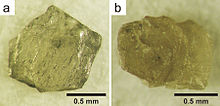藍絲黛爾石 (英語:Lonsdaleite )也译做郎士德碳 ,又因晶體結構及特性稱作六方金剛石 (英語:hexagonal diamond )、六方碳 。藍絲黛爾石是一種六方晶系 的金剛石 ,屬於碳同素異形體 的一種構形,咸信為流星 上的石墨 在墜入地球 時所形成。撞擊時的巨大壓力及熱量改變石墨構形形成金剛石,卻又保留了石墨的平行六邊形 晶格,並構成了立方的六方晶格 。第一次鑑別出藍絲黛爾石是1967年在美國 亞利桑那州 的巴林杰隕石坑 [ 4] 魔谷隕石 」中所發現,並以20世紀的愛爾蘭晶體學家 和英國皇家學會 凱瑟琳·朗斯代爾
藍絲黛爾石具有透明棕黃色的外觀,折射率 在2.40至2.41之間,比重 在3.2至3.3之間。它的莫氏硬度 在7至8之間,而金剛石的莫氏硬度則為10。藍絲黛爾石較低的硬度主要原因是因为天然形成礦石不純且不完美所致。但如果以人工合成則比鑽石硬58%,而抗壓程度也比鑽石高了大約58%。[ 5]
藍絲黛爾石也已經在實驗室中(1966年或更早; 1967年出版[ 6] 合成 ,方法是在靜態壓力機或炸藥中壓縮和加熱石墨 [ 7]
矿物学模拟预测蓝丝黛尔石在<100> 面上比钻石硬58%,能抵抗152 GPa 的压入压力,而钻石在压入到97 GPa时就会断裂。[ 8] IIa 钻石
蓝丝黛尔石的外推特性受到质疑,特别是其极高的硬度,因为在晶体学 检查下的样品没有显示出块状六方晶格结构,而是结构缺陷主要是六边形结构的传统的立方钻石结构。[ 9] X射线衍射 数据的定量分析表明,它存在大约等量的六方和立方堆积序列。因此,有人提出“堆叠无序的钻石”是对蓝丝黛尔石最准确的结构描述。[ 10] 原位 X射线衍射进行的冲击实验表明,在与陨石撞击相当的动态高压环境中会产生相对较纯的蓝丝黛尔石。[ 11] [ 12]
来自波皮盖陨石坑 的钻石样品:(a) 是纯钻石,而 (b) 是含有一些藍絲黛爾石 杂质的钻石。 藍絲黛爾石存在于隕石 的金剛石上,是一個連結在金剛石上非肉眼可見的顯微晶體。除魔谷隕石外,在美國新墨西哥州 的「肯納隕石」(Kenna meteorite)、南極洲 維多利亞地 的艾倫丘陵隕石 77283(Allan Hills (ALH) 77283)上亦有發現。[ 13] 克洛维斯彗星假说 支持者发现,在墨西哥瓜纳华托州 奎采奥湖 的沉积物中发现了d间距与蓝丝黛尔石一致的材料。[ 14] 泥炭 沉积物中,被认为是通古斯大爆炸 是由流星 而非彗星 碎片引起的证据。[ 15] [ 16]
除了通过加压或使用炸药压缩和加热石墨 ,[ 17] [ 18] 化学气相沉积 [ 19] [ 20] [ 21] 聚甲炔 [ 22] [ 23]
2020年,澳大利亚国立大学 的研究人员偶然发现使用金刚石压砧 就可以在室温下生产蓝丝黛尔石。[ 24] [ 25]
2021年,华盛顿州立大学的冲击物理研究所发表了一篇论文,称他们创造了足够大的蓝丝黛尔石晶体来测量其硬度,证实它们比普通的立方钻石更坚硬。[ 26]
^ Lonsdaleite on Mindat.org . [2005-09-10 ] . (原始内容存档 于2021-03-31). ^ Handbook of Mineralogy (PDF) . [2013-02-11 ] . (原始内容存档 (PDF) 于2012-03-30). ^ Lonsdaleite data from Webmineral . [2005-09-10 ] . (原始内容存档 于2021-03-31). ^ 存档副本 . [2005-09-10 ] . (原始内容 存档于2006-10-11). ^
Carlomagno, G.M.; Brebbia, C.A. Computational Methods and Experimental Measurements XV . WIT Press. 2011. ISBN 978-1-84564-540-3
^ Bundy, F. P.; Kasper, J. S. Hexagonal Diamond—A New Form of Carbon. Journal of Chemical Physics. 1967, 46 (9): 3437. Bibcode:1967JChPh..46.3437B doi:10.1063/1.1841236 ^ He, Hongliang; Sekine, T.; Kobayashi, T. Direct transformation of cubic diamond to hexagonal diamond. Applied Physics Letters. 2002, 81 (4): 610. Bibcode:2002ApPhL..81..610H doi:10.1063/1.1495078 ^
Pan, Zicheng; Sun, Hong; Zhang, Yi & Chen, Changfeng. Harder than diamond: Superior indentation strength of wurtzite BN and lonsdaleite. Physical Review Letters. 2009, 102 (5): 055503. Bibcode:2009PhRvL.102e5503P PMID 19257519 doi:10.1103/PhysRevLett.102.055503 简明摘要 – Physorg.com (12 February 2009).
^
Nemeth, P.; Garvie, L.A.J.; Aoki, T.; Natalia, D.; Dubrovinsky, L.; Buseck, P.R. Lonsdaleite is faulted and twinned cubic diamond and does not exist as a discrete material. Nature Communications. 2014, 5 : 5447. Bibcode:2014NatCo...5.5447N PMID 25410324 doi:10.1038/ncomms6447
^ Salzmann, C.G.; Murray, B.J.; Shephard, J.J. Extent of stacking disorder in diamond . Diamond and Related Materials. 2015, 59 : 69–72 [2021-12-21 ] . Bibcode:2015DRM....59...69S S2CID 53416525 arXiv:1505.02561 doi:10.1016/j.diamond.2015.09.007 原始内容 存档于2021-12-21). ^
Kraus, D.; Ravasio, A.; Gauthier, M.; Gericke, D.O.; Vorberger, J.; Frydrych, S.; Helfrich, J.; Fletcher, L.B.; Schaumann, G.; Nagler, B.; Barbrel, B.; Bachmann, B.; Gamboa, E.J.; Goede, S.; Granados, E.; Gregori, G.; Lee, H.J.; Neumayer, P.; Schumaker, W.; Doeppner, T.; Falcone, R.W.; Glenzer, S.H.; Roth, M. Nanosecond formation of diamond and lonsdaleite by shock compression of graphite . Nature Communications. 2016, 7 : 10970. Bibcode:2016NatCo...710970K PMC 4793081 PMID 26972122 doi:10.1038/ncomms10970
^
Turneaure, Stefan J.; Sharma, Surinder M.; Volz, Travis J.; Winey, J.M.; Gupta, Yogendra M. Transformation of shock-compressed graphite to hexagonal diamond in nanoseconds . Science Advances. 2017-10-01, 3 (10): eaao3561. ISSN 2375-2548 PMC 5659656 PMID 29098183 doi:10.1126/sciadv.aao3561
^
Kaminskii, F.V.; G.K. Blinova; E.M. Galimov; G.A. Gurkina; Y.A. Klyuev; L.A. Kodina; V.I. Koptil; V.F. Krivonos; L.N. Frolova; A.Y. Khrenov. Polycrystalline aggregates of diamond with lonsdaleite from Yakutian [Sakhan] placers. Mineral. Zhurnal. 1985, 7 : 27–36.
^
Israde-Alcantara, I.; Bischoff, J.L.; Dominguez-Vazquez, G.; Li, H.-C.; Decarli, P.S.; Bunch, T.E.; et al. Evidence from central Mexico supporting the Younger Dryas extraterrestrial impact hypothesis . Proceedings of the National Academy of Sciences. 2012, 109 (13): E:738–747. Bibcode:2012PNAS..109E.738I PMC 3324006 PMID 22392980 doi:10.1073/pnas.1110614109
^ Kvasnytsya, Victor; Wirth; Dobrzhinetskaya; Matzel; Jacobsend; Hutcheon; Tappero; Kovalyukh. New evidence of meteoritic origin of the Tunguska cosmic body . Planetary and Space Science. August 2013, 84 : 131–140 [2021-12-19 ] . Bibcode:2013P&SS...84..131K doi:10.1016/j.pss.2013.05.003 存档 于2023-03-04). ^ Redfern, Simon. Russian meteor shockwave circled globe twice . BBC News. British Broadcasting Corporation . [28 June 2013] . (原始内容 存档于2022-05-17). ^
Bundy, F.P.; Kasper, J.S. Hexagonal diamond — a new form of carbon. Journal of Chemical Physics. 1967, 46 (9): 3437. Bibcode:1967JChPh..46.3437B doi:10.1063/1.1841236
^
He, Hongliang; Sekine, T.; Kobayashi, T. Direct transformation of cubic diamond to hexagonal diamond. Applied Physics Letters. 2002, 81 (4): 610. Bibcode:2002ApPhL..81..610H doi:10.1063/1.1495078
^
Bhargava, Sanjay; Bist, H.D.; Sahli, S.; Aslam, M.; Tripathi, H.B. Diamond polytypes in the chemical vapor deposited diamond films. Applied Physics Letters. 1995, 67 (12): 1706. Bibcode:1995ApPhL..67.1706B doi:10.1063/1.115023
^
Nishitani-Gamo, Mikka; Sakaguchi, Isao; Loh, Kian Ping; Kanda, Hisao; Ando, Toshihiro. Confocal Raman spectroscopic observation of hexagonal diamond formation from dissolved carbon in nickel under chemical vapor deposition conditions. Applied Physics Letters. 1998, 73 (6): 765. Bibcode:1998ApPhL..73..765N doi:10.1063/1.121994
^
Misra, Abha; Tyagi, Pawan K.; Yadav, Brajesh S.; Rai, P.; Misra, D.S.; Pancholi, Vivek; Samajdar, I.D. Hexagonal diamond synthesis on h-GaN strained films. Applied Physics Letters. 2006, 89 (7): 071911. Bibcode:2006ApPhL..89g1911M doi:10.1063/1.2218043
^
Nur, Yusuf; Pitcher, Michael; Seyyidoğlu, Semih; Toppare, Levent. Facile synthesis of poly(hydridocarbyne): A precursor to diamond and diamond-like ceramics. Journal of Macromolecular Science, Part A. 2008, 45 (5): 358. S2CID 93635541 doi:10.1080/10601320801946108
^
Nur, Yusuf; Cengiz, Halime M.; Pitcher, Michael W.; Toppare, Levent K. Electrochemical polymerizatıon of hexachloroethane to form poly(hydridocarbyne): A pre-ceramic polymer for diamond production. Journal of Materials Science. 2009, 44 (11): 2774. Bibcode:2009JMatS..44.2774N S2CID 97604277 doi:10.1007/s10853-009-3364-4
^ Lavars, Nick. Scientists produce rare diamonds in minutes at room temperature . New Atlas. 18 November 2020 [12 February 2021] . (原始内容存档 于2021-01-18). ^ McCulloch, Dougal G.; Wong, Sherman; Shiell, Thomas B.; Haberl, Bianca; Cook, Brenton A.; Huang, Xingshuo; Boehler, Reinhard; McKenzie, David R.; Bradby, Jodie E. Investigation of room temperature formation of the ultra-hard nanocarbons diamond and lonsdaleite . Small. 2020, 16 (50): 2004695 [2020-11-21 ] . ISSN 1613-6829 PMID 33150739 S2CID 226259491 doi:10.1002/smll.202004695 原始内容 存档于2022-05-07). ^ Lab made hexagonal diamonds stiffer than natural cubic diamonds . Phys.org. March 2021 [2021-12-18 ] . (原始内容 存档于2022-05-26).
Mindat.org (页面存档备份 ,存于互联网档案馆 ) accessed 3/13/05.Webmineral (页面存档备份 ,存于互联网档案馆 ) accessed 3/13/05.Anthony, J.W., et al (1995), Mineralogy of Arizona , 3rd.ed.
Frondel, C. & U.B. Marvin (1967), Lonsdaleite, a new hexagonal polymorph of diamond. Nature: 214: 587-589
Frondel, C. & U.B. Marvin (1967), Lonsdaleite, a hexagonal polymorph of diamond, Am.Min.: 52
Bianconi, P. et al (2004), Diamond and Diamond-like Carbon from a Preceramic Polymer. J. Am. Chem. Soc. Vol. 126, No. 10, 3191-3202
sp3 杂化 sp2 杂化 sp杂化 sp3 /sp2 杂化混合 其他 假想形态 相关

